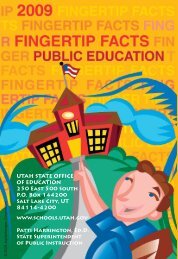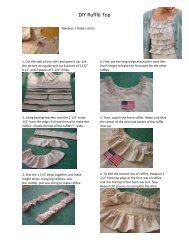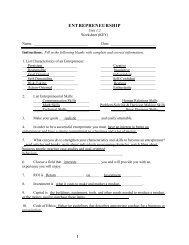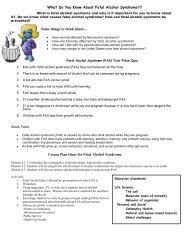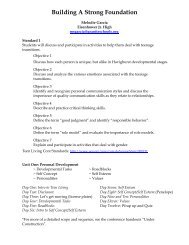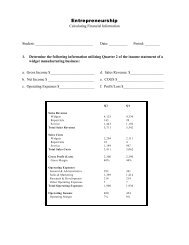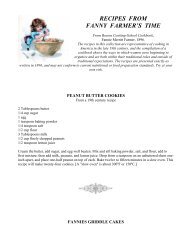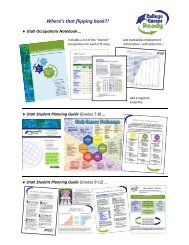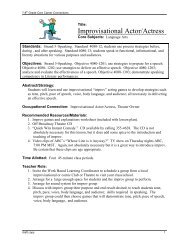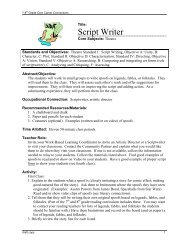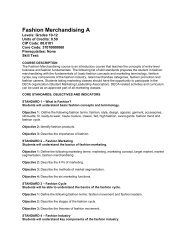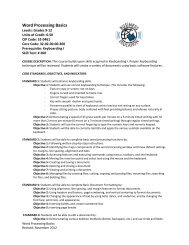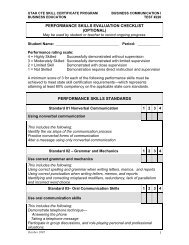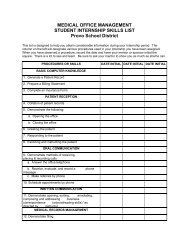Digital Electronics - Utah Education Network
Digital Electronics - Utah Education Network
Digital Electronics - Utah Education Network
You also want an ePaper? Increase the reach of your titles
YUMPU automatically turns print PDFs into web optimized ePapers that Google loves.
Project Lead The Way ® “<strong>Digital</strong> <strong>Electronics</strong>”<br />
Technology <strong>Education</strong> – Applied Technology <strong>Education</strong><br />
<strong>Utah</strong> State Office of <strong>Education</strong><br />
CIP Code 210121<br />
COURSE DESCRIPTION: This course introduces students to applied digital logic, a key element of<br />
careers in engineering and engineering technology. This course explores the smart circuits found in<br />
watches, calculators, video games, and computers. Students use industry-standards computer software<br />
in testing and analyzing digital circuitry. They design circuits to solve problems, export their designs to<br />
a printed circuit auto-routing program that generates printed circuit boards, and use appropriate<br />
components to build their designs. Students use mathematics and science in solving real-world<br />
engineering problems. This course covers several topics, including:<br />
• Analog and digital fundamentals<br />
• Number systems and binary addition<br />
• Logic gates and functions<br />
• Boolean algebra and circuit design<br />
• Decoders, multiplexers and de-multiplexers<br />
STANDARD & OBJECTIVES<br />
210121.01 FUNDAMENTALS<br />
210121.0101 Students will be able to identify hazards in the lab and know locations of the safety<br />
equipment and how to use it. (Safety)<br />
210121.0102 Students will understand the causes of and the dangers from electric shock and explain<br />
methods to prevent it. (Safety)<br />
210121.0103 Students will understand that the process of designing an electronic circuit takes into<br />
account many factors, including environment concerns, and will be familiar with<br />
precautionary measures. (Safety)<br />
210121.0104 Students will be able to label the parts of the atom. (Basic Electron Theory)<br />
210121.0105 Students will explain the relationship of quantum energy required to strip away electrons<br />
from atoms to being classified as an insulator or conductor. (Basic Electron Theory)<br />
210121.0106 Students will learn how to apply Kirchhoff’s voltage and current laws to closed loops.<br />
(Basic Electron Theory)<br />
210121.0107 Students will be able to define and explain the difference between direct and alternating<br />
currents. (Basic Electron Theory)<br />
210121.0108 Students will be able to re-write any number using conventional prefix definitions.<br />
(Scientific Prefixes)<br />
210121.0109 Students will understand the material makeup of resistors and how they are used in<br />
circuit design. (Resistors)<br />
210121.0110 Students will understand the symbols associated with resistors. (Resistors)<br />
210121.0111 Students will be able to correctly setup lab equipment to measure resistor values in order<br />
to compare measured and rated values. (Resistors)<br />
210121.0112 Students will calculate the tolerance levels of various resistors to determine if the<br />
measured value is within specifications. (Resistors)<br />
Draft Page 1 12/17/2003
210121.0103 Students will be able to draw and label the parts of a simple circuit. (Laws)<br />
210121.0104 Students will build and test a variety of series and parallel circuits, using simulation<br />
software and proto-boards, to prove the accuracy of Ohm’s and Kirchhoff’s laws.<br />
(Laws)<br />
210121.0105 Students will correctly select and utilize electrical meters to determine voltage, resistance<br />
and current in simple circuits. (Laws)<br />
210121.0106 Students will calculate the resistance, current and voltage in a circuit using Ohm’s Law.<br />
(Laws)<br />
210121.0107 Students will describe the component parts of a capacitor and describe how a capacitor<br />
holds a static charge. (Capacitance)<br />
210121.0108 Students will use and understand the units of measurement for capacitors. (Capacitance)<br />
210121.0109 Students will be able to calculate the value of capacitors mathematically and through the<br />
use of instrumentation. (Capacitance)<br />
210121.0110 Students will be familiar with different types of capacitors and their voltage polarity<br />
requirements. (Capacitance)<br />
210121.0111 Students will be able to draw a digital waveform and identify the anatomy of the<br />
waveform. (Analog and <strong>Digital</strong> Waveforms)<br />
210121.0112 Students will differentiate between digital and analog signals when given the waveforms.<br />
(Analog and <strong>Digital</strong> Waveforms)<br />
210121.0113 Students will wire and test a free-running clock circuits using a 555 timer. (Analog and<br />
<strong>Digital</strong> Waveforms)<br />
210121.0114 Students will calculate the output frequency of a clock circuits using observations and the<br />
oscilloscope. (Analog and <strong>Digital</strong> Waveforms)<br />
210121.02 NUMBER SYSTEMS<br />
210121.0201 Students will understand numerical place value. (Conversions)<br />
210121.0202 Students use mathematical symbols to represent different bases and will communicate<br />
concepts using different number systems. (Conversions)<br />
210121.0203 Students will demonstrate the relationship of binary and hexadecimal to bits and bytes of<br />
information used in computers. (Conversions)<br />
210121.0204 Students will convert values from one number system to another. (Conversions)<br />
210121.03 GATES<br />
210121.0301 Students will use schematics and symbolic Algebra to represent digital gates in the<br />
creation of solutions to design problems. (Logic Gates)<br />
210121.0302 Students will identify the name, symbol, and function and create the truth table, and<br />
Boolean Expression for the basic logic gates through research and experimentation.<br />
(Logic Gates)<br />
210121.0303 Students will apply logic to design and create, using gates, solutions to a problem. (Logic<br />
Gates)<br />
210121.04 BOOLEAN ALGEBRA<br />
Draft Page 2 12/17/2003
210121.0401 Students will recognize the relationship between the Boolean expression, logic diagram,<br />
and truth table. (Boolean Expressions)<br />
210121.0402 Students will be able to create Boolean Expressions, logic circuit diagrams or truth tables<br />
from information provided in the solution of design problems. (Boolean Expressions)<br />
210121.0403 Students will appropriately select the Sum-of-Products or the Product-of-Sums form of a<br />
Boolean Expression to use in the solution of a problem. (Boolean Expressions)<br />
210121.0404 Students will apply the rules of Boolean algebra to logic diagrams and truth tables to<br />
minimize the circuit size necessary to solve a design problem. (Logic Simplifications)<br />
210121.0405 Students will use DeMorgan’s Theorem to simplify a negated expression and to convert a<br />
SOP to a POS and visa versa in order to save resources in the production of circuits.<br />
(Logic Simplifications)<br />
210121.0406 Students will formulate and employ a Karnaugh Map to reduce Boolean expressions and<br />
logic circuits to their simplest forms. (Logic Simplifications)<br />
210121.0407 The students will create circuits to solve a problem using NAND or NOR gates to<br />
replicate all logic functions. (Duality of Logic Functions)<br />
210121.0408 The students will apply their understanding of the workings of NOR and NAND gates to<br />
make comparisons with standard combinational logic solutions to determine amount of<br />
resource reduction. (Duality of Logic Functions)<br />
210121.05 BOOLEAN ALGEBRA AND CIRCUIT DESIGN<br />
210121.0501 Students will restate and simplify a digital design problem as part of the systematic<br />
approach to solving a problem. (Paradigm for Combinational Logic Problems)<br />
210121.0502 Students will design, construct, build, troubleshoot, and evaluate a solution to a design<br />
problem. (Paradigm for Combinational Logic Problems)<br />
210121.0503 Students will present an oral report presenting a solution and evaluation of a design<br />
problem of their choice. (Paradigm for Combinational Logic Problems)<br />
210121.0504 Students will discover the code to create numbers on a seven segment display by<br />
experimentation. (Specific Application MSI Gates)<br />
210121.0505 Students will design a circuit to control a seven segment display with a decimal to BCD<br />
encoder and a display driver. (Specific Application MSI Gates)<br />
210121.0506 Students will control the flow of data by utilizing Multiplexers and De-multiplexers.<br />
(Specific Application MSI Gates)<br />
210121.0507 Students will be able to design and implement combinational logic circuits using<br />
reprogrammable logic devices. (Programmable Logic Devices (PLD))<br />
210121.0508 Students will create PLD logic files that define combinational circuit designs using<br />
Boolean Expressions. (Programmable Logic Devices (PLD))<br />
210121.0509 Students will understand and use logic compiler software to create JEDEC files for<br />
programming PLDs. (Programmable Logic Devices (PLD))<br />
210121.06 ADDING<br />
210121.0601 Students will demonstrate understanding of binary addition and subtraction by designing<br />
circuits to produce correct answers. (Binary Addition)<br />
210121.0602 Students will create and prove the truth table for both half and full adders. (Binary<br />
Addition)<br />
Draft Page 3 12/17/2003
210121.0603 Students will design, construct and test adder circuits using both discrete gates and MSI<br />
gates. (Binary Addition)<br />
210121.07 FLIP-FLOPS<br />
210121.0701 Students will construct and test simple latches and flip-flops from discrete gates.<br />
(Introduction to Sequential Logic)<br />
210121.0702 Students will interpret, design, draw, and evaluate circuits using the logic symbols for<br />
latches and flip-flops. (Introduction to Sequential Logic)<br />
210121.0703 Students will be able to interpret waveform diagrams from circuits they construct and<br />
compare them with combinational waveforms. (Introduction to Sequential Logic)<br />
210121.0704 Students will compare and contrast operation of synchronous with asynchronous flip-flop<br />
circuits they construct. (The J-K Flip-Flop)<br />
210121.0705 Students will be able to create and interpret timing diagrams and truth tables for J-K Flip-<br />
Flops. (The J-K Flip-Flop)<br />
210121.0706 Students will understand the different types of triggers used by latches and flip-flops and<br />
select the appropriate one for the circuits they design. (Triggers)<br />
210121.0707 Students will analyze timing diagrams that reflect triggering to identify distinguishing<br />
characteristics. (Triggers)<br />
210121.0708 Students will conduct experiments with clock pulse width to determine the effect on the<br />
accuracy of data transmission. (Flip-Flop Timing Considerations)<br />
210121.0709 Students will assemble circuits and compile information about the various applications of<br />
flip-flops. (Elementary Applications of Flip-Flops)<br />
210121.08 SHIFT REGISTERS AND COUNTERS<br />
210121.0801 Students will conduct experiments to determine the basic principles of how shift registers<br />
work. (Shift Registers)<br />
210121.0802 Students will evaluate the use of shift registers in product design and the speeds at which<br />
those products run. (Shift Registers)<br />
210121.0803 Students will create a circuit using discrete flip-flops to discover the operation and<br />
characteristics of asynchronous counters. (Asynchronous Counters)<br />
210121.0804 Students will design, simulate, build and test Mod counters using discrete gates in the<br />
solution to a design problem. (Asynchronous Counters)<br />
210121.0805 Students will design, simulate, build and test asynchronous Mod counters using an<br />
integrated counter chip (MSI). (Asynchronous Counters)<br />
210121.0806 Students will design, simulate, build and test synchronous Mod counters using discrete<br />
gates to solve a problem. (Synchronous Counters)<br />
210121.0807 Students will design, simulate, build and test synchronous Mod counters using an<br />
integrated counter chip in the solution to a design problem. (Synchronous Counters)<br />
210121.09 FAMILIES AND SPECIFICATIONS<br />
210121.0901 Students will be able to interpret the graphs, charts and written materials contained in a<br />
data sheet and apply it to a design problem. (Logic Families)<br />
Draft Page 4 12/17/2003
210121.0902 Students will be able to correctly setup and use an oscilloscope to observe and measure<br />
propagation delay in a digital circuit. (Logic Families)<br />
210121.0903 Students will be able to define, calculate, and measure noise margin, drive capabilities,<br />
fan-out and propagation delay. (Logic Families)<br />
210121.0904 Students will be able to list safety precautions for handling CMOS chips. (Logic<br />
Families)<br />
210121.10 MICROPROCESSORS<br />
210121.1001 Students will be able to formulate a flow chart to correctly apply basic programming<br />
concepts in the planning of a project . (Microcontrollers)<br />
210121.1002 Students will be able to design and create a program, using correct syntax, to evaluate<br />
data and make decisions based on information gathered from the environment using<br />
external digital and analog sensors. (Microcontrollers)<br />
210121.1003 Students will create an interface to allow them to inspect, evaluate and manage program<br />
parameters in the microprocessor during the operation of a program. (Microcontrollers)<br />
210121.1004 Students will be able to design and create a program in correct syntax allowing a<br />
microprocessor to evaluate external data in order to operate motors and other devices to<br />
control the external environment. (Interfacing with Motors)<br />
210121.1005 Students will appropriately select, size, and implement interface devices to control<br />
external devices. (Interfacing with Motors)<br />
210121.1006 Students will design and create programming to control the position of stepper motors.<br />
(Interfacing with Motors)<br />
Draft Page 5 12/17/2003



